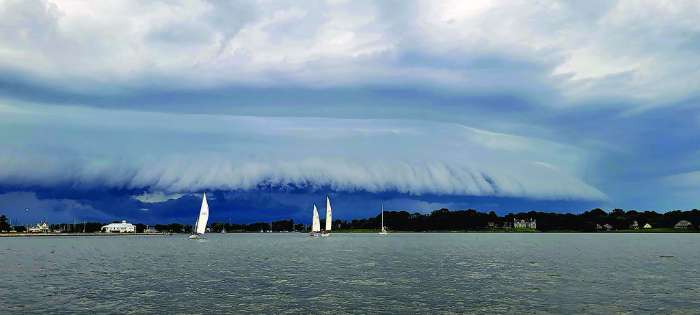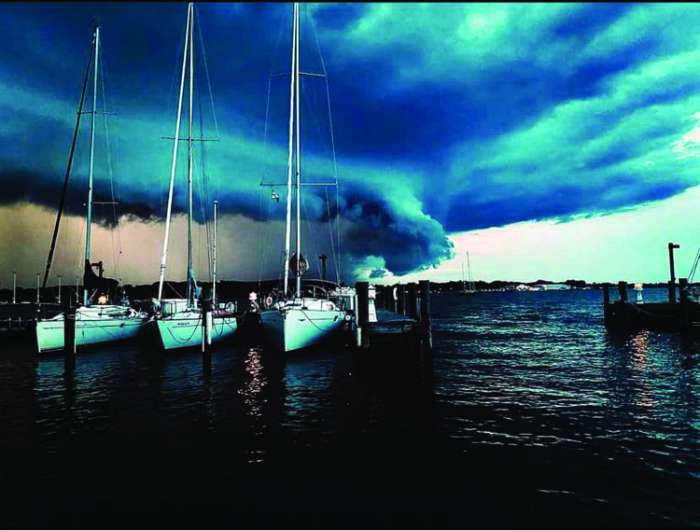Lessons for All Racing Sailors Learned at the Mackinac Race
Anybody who sails in North America during the summer months has probably encountered powerful localized storms. Those who raced in the 2022 Mackinac Race from Chicago to Mackinac got an abject lesson in just how big and scary a factor they can be. Aboard Sledd Shellhorse’s well-traveled Carkeek 40, Meridian XI, our day started with one of the most terrifying weather briefings I have heard in a long time.
Mark Thornton, Great Lakes weather expert, gave a private chat that let us know that with as much certainty as any forecast could that we were going to get pounded. A perfect mix of warm and cold fronts was going to come together directly over our projected path and create a line of organized squalls with potential winds of 40-60 knots, driving rain and two-inch hail. Good times. As we sailed towards the potential maelstrom it was hard to imagine what was coming as we enjoyed idyllic downwind conditions in 12-16 knots of breeze and plentiful sunshine.

There was plenty of discussion, however. Ron Mclean, a veteran team member, made the comment that if we were just cruising, we would roll up a couple of turns on the sails or maybe just take them all down and cautiously prepare for the worst. I recalled teaching a Safety at Sea lecture on heavy air where the first lesson upon facing a forecast like this was simply to say “no.” The wise thing is just to stay home and wait it out. In fact, some of the very smart money aboard several top programs did just that. We were determined to race and charged on. Here are some thoughts on how to survive when you are unlucky enough to get caught out but want to keep on racing.
Preparation
One of the problems with race boats is that we just don’t sail very often in really windy conditions. If it is blowing over 25 and we are course-racing, most race committees have the sanity to cancel racing. Offshore you don’t have the luxury. The ability to shorten sail by reefing or even taking down the mainsail, and having a proper heavy weather jib are key. Unfortunately, many modern racing boats with big fractional mainsails don’t even have a reef in their race mainsail, much less have gone through the mechanics and gear setup which allow one to put it in easily and reliably.
It is essential to have the rigging you will need organized and to have the crew practice taking a reef in normal conditions. There are usually rigging issues to address. Is the tack strop for the reefed tack long enough? Does it pull forward at the correct angle to unload the bottom of the sail above the reef? How hard is it to put it on? Which winch am I going to use for the clew reef? Reefing is complicated on pure race boats which have only a bolt rope holding the sail in the mast.
When the halyard is lowered, the sail is all over the place and wants to pull out of the groove at the bottom. On the highest tech masts the halyard is secured on a lock, which is great to reduce weight and compression, but it means the sail has to be fully unloaded (head to wind) to get it off the lock. The mainsail halyard has to be raised above the mechanism to get it on or off. Not easy in 30 knots of breeze. Knowing the sequence and who is going to do what becomes critical. True offshore racing boats skip the bolt rope and use a track with cars firmly attaching the sail to the mast, keeping it under control, and making raising, lowering, and reefing easier.
Likewise waiting until the breeze arrives will make a headsail change almost impossible and fraught with danger. On Meridian we went to the heavy jib well before the first squall line was scheduled to come through. Okay to be a little underpowered at times.

Decision time
If it is daylight out, a squall line with potential big breeze is usually quite visible as a mass of black clouds in a defined line. At night, it is much more difficult to figure out what is going on and how scared you should be. Radar is a big help, as are local weather station wind readings. As the first line of squalls approached right on time with last light of day, we were just offshore of Milwaukee and had good cellphone coverage. Radar made it clear where the big red blotches were heading. Wind readings from the local airport just to the west gave a good indication of how much breeze to expect (not more than 30). Later that evening, just after midnight when the second even bigger line of squalls came through, we had no such luxury. Just one of the most frightening skies you have ever seen, wind shifting all over the place, and the most incredible lighting storm I have ever witnessed. The information we had dictated our tactics.
Two approaches to the problem
For the first line we chose to keep the mainsail up and to run off aggressively. For this to work the first key was room to leeward. (If there had been a lee shore, this wouldn’t have been an option.) One of the reasons we had worked west to effectively meet the storm lines was to have room to run off. Typically, intense wind lines are of relatively short duration. You just have to be able to hang on for the first 20-40 minutes, and things will get better. Off we went at 20-25 knots in a breeze that built into the high 30s.
There is really only one angle you can sail under any sort of control in this much wind: 145-150 degrees true wind angle is the magic angle. Any closer than this, and the boat will be overpowered. Lower, and you risk accidental gybe and auguring into waves. It takes a good helmsperson. This is not for the faint at heart. Were we on course? Not even close. Not that you could really see the instruments in the driving rain, but we were only generally heading north, nowhere near where we wanted to go. Fortunately, things gradually toned down until the wind was in the high 20s. This gave us another option.
With the breeze down, we could head up and sail the other possible angle: a close reach. With mainsail and jib both luffing evenly, we could just hang on in the big puffs, and we were pretty much on course. If we had tried to sail a close reach with full mainsail and jib in 35-40 knots, we would have flogged the sails to death. You could only have pulled this off with a reef or no mainsail at all.
Normally this type of line squall is a “one and done thing.” The front passes, and all is back to normal. Not this night. The perfect intersection of the two fronts with all the mixing of warm and cold air provided hours of excitement. There were squalls and lightening almost all night. The second major round required a different tactical approach. Since it was pitch dark and we had no clear picture, more caution was indicated. This was reinforced by a sudden 180-degree shift in breeze direction (a sure sign of bad things possibly coming). We decided to take the mainsail completely down while we could for this one. Fortunately the sail came off the lock and down into the cockpit where eight people could sit on it. When the breeze built to nearly 40 in less than two minutes, we were feeling pretty smart. With just a heavy jib, we could sail a close reaching angle that was headed roughly where we wanted to go; when you could see the instruments.
Eventually the wind dropped. In fact, it got very light and unstable, coming in from all directions. We stayed throttled back for a good while, since the skies were still ominous, and we were a little gun shy by this point. We figured that boats were scattered all over Lake Michigan, so we could afford to be cautious.

The final lesson
The breeze, while never completely stable did fill in with reasonable volume (20 knots): time to get back to racing. This meant getting the mainsail back up. which required a full rotation to nearly head to wind to unload the sail so that we could over-hoist and get it on lock. Except it would not go on lock. Repeatedly we tried. Finally on the 10th or 12th time, the bottom of the mainsail track (which on this carbon mast was glued on) simply tore off the mast. Race over.
We had exercised reasonable judgement and solid tactics, but preparation ultimately let us down. We had failed to address the fact, though we were all aware of the issue, that you can’t reliably go offshore with a glued on track and a mainsail with a bolt rope only. Needless to say, the next time Meridian XI goes into the water there will be a new track with cars, mechanical as well as adhesive attachment system, and a simplified reefing system.
~By Dave Flynn of Quantum Sails
Questions? Email [email protected]




